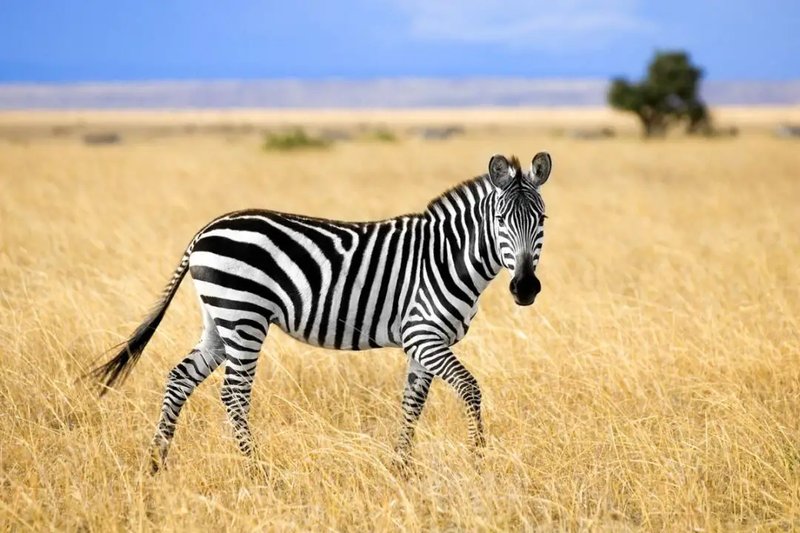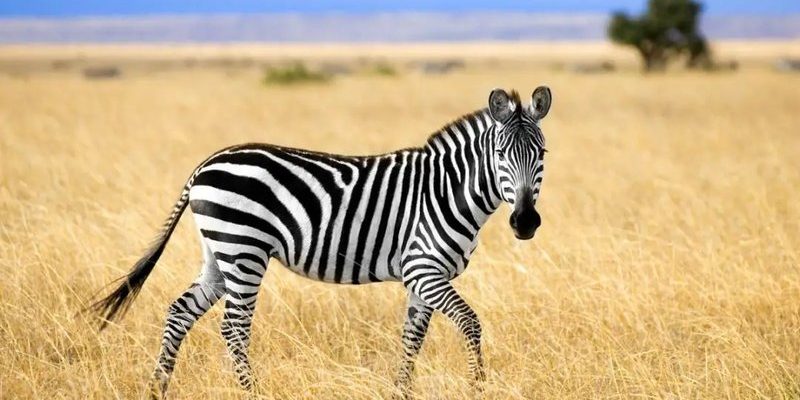
Just like a family resemblance, many animals share traits with the Grevy’s zebra. Whether they share similar habitats, features, or behaviors, spotting the differences can be entertaining and educational. Imagine you’re at a wildlife park, and your curiosity sparks—what other creatures might resemble this striking zebra? Let’s dive in together and explore **ten animals similar to the Grevy’s zebra and how to tell them apart**.
1. Plains Zebra
When you think of the classic zebra, the **plains zebra** is likely what comes to mind. These creatures roam the savannas of Africa, boasting broader stripes than their Grevy’s cousins. While both species are part of the same family, the plains zebra’s stripes are more varied in width and pattern.
One of the easiest ways to distinguish a plains zebra from a Grevy’s zebra is by looking at their **size and build**. Plains zebras are typically smaller and stockier. They also have a more compact head, while Grevy’s zebras have a longer, more horse-like head. If you find yourself observing these two together, you’ll quickly see how their body shapes vary.
Additionally, the behavior of these zebras can differ. Plains zebras tend to form large herds for safety, while Grevy’s zebras are often found in smaller family groups. This social structure can help you identify which species you’re looking at when you’re out in the wild!
2. Mountain Zebra
Another striped cousin is the **mountain zebra**, which prefers the rugged, hilly regions of southern Africa. This zebra has a distinctive appearance, featuring a unique grid pattern of stripes on its back and a more rounded body shape.
You might notice that mountain zebras have a **dorsal stripe** that runs down their spines, something that Grevy’s zebras lack. Their stripes also tend to be more tightly packed, giving them a visually distinct look.
Mountain zebras are known to climb steep terrains, making them quite agile. If you see a zebra scaling rocky hillsides with ease, it’s probably a mountain zebra. Keep an eye out for how they interact with their environment; their adaptability can be quite telling.
3. Okapi
While it might not look like it at first glance, the **okapi** is often referred to as the “giraffe’s closest relative.” With its dark body and white-striped legs, it might remind you of a zebra. However, don’t be fooled! The okapi is a unique species all on its own.
What sets the okapi apart from the Grevy’s zebra? Well, for starters, its body shape is more similar to that of a giraffe, and it lacks the characteristic stripes across its whole body. Instead, the stripes are limited to the legs, which help camouflage the okapi in its forest habitat.
When you see an okapi, pay attention to its long, flexible tongue—it’s a handy tool for reaching leaves high in the trees. Their dietary habits differ significantly from those of zebras, giving you another clue to their identity.
4. Donkey
You might chuckle at the thought, but the humble **donkey** is another creature that can be confused with a zebra at times. Some breeds have stripes along their bodies or legs. It’s like looking at a zebra that lost a bet—stripes but not quite the same.
Donkeys are much more robust and have longer ears than Grevy’s zebras. If you’re out on a farm, observing the differences in size and shape is crucial. Donkeys are generally shorter and stockier than zebras.
What’s more, donkeys are domesticated animals and can exhibit a variety of colors beyond just gray or brown. If you see a striped donkey munching hay, you’ll have an interesting conversation starter, but it’s definitely not a zebra!
5. Horse
It’s no surprise to find that the horse is another close relative of the zebra, but did you know that some horse breeds can closely resemble our striped friend? Take the **Appaloosa** horse, for example, which can have spotted coats that mimic some of the unique patterns of zebras.
However, horses are typically larger and have more elongated heads than Grevy’s zebras. The differences in the length of the neck and overall body structure are noticeable. Plus, horses don’t have that distinct zigzag pattern that defines zebras.
When observing these two animals, look for their **behavioral differences**. Horses are usually more social with humans and can often be trained for riding, while zebras tend to retain their wild instincts. It’s fascinating how these similarities can sometimes be deceptive!
6. Bongo
The striking **bongo**, a type of antelope found in the rainforests of Africa, has a rich reddish-brown coat with bold white stripes. While its coloration is different, its striped pattern can remind you of a zebra, but with a twist.
Bongos are significantly larger and have a different body shape and habitat preference. They thrive in dense foliage, where their stripes help them blend into the shadows. If you spot one in the wild, you’ll see how their stripes are more about camouflage than the bold display of a zebra’s markings.
The bongo’s curved horns and unique stature set it apart, making it a fascinating animal to watch as it gracefully navigates the underbrush. It’s a different kind of beauty compared to the flamboyant Grevy’s zebra.
7. Giraffe
We can’t forget about the **giraffe**, often called the “tallest animal on Earth.” With their long necks and patchy coats, they might seem worlds apart from zebras. But if you look closely, you’ll see that both animals share a wild charm and striking patterns.
While zebras have narrow, vertical stripes, giraffes have irregular patches in shades of brown and tan. Interestingly, both animals use their patterns for social interaction and camouflage in their respective environments.
Giraffes are also herbivores and have a different diet compared to zebras, which often graze on grass and other vegetation. Watching a giraffe nibble on leaves high up in the trees can be a mesmerizing experience—just remember, they’re not hanging out with the zebras in the grasslands!
8. Tapir
The **tapir** is another unique animal that may catch your attention. With its stocky body, short legs, and elongated snout, it’s an oddball but charming in its own right. Tapirs have a smooth body with lighter spots and stripes, especially when they’re young.
While tapirs and Grevy’s zebras are from completely different families, their shared habitats in tropical regions can sometimes lead to similar environments. Look for the distinctive **snout** of a tapir as it forages in the underbrush—it’s quite different from a zebra’s face.
These animals are mostly nocturnal and are often seen near water sources. If you spot one swimming, you’ll quickly see how their lifestyle differs significantly from that of a zebra, making identification a breeze.
9. Zebra Duiker
The **zebra duiker**, a small antelope found in Africa, is another interesting animal with stripes. With its clever markings mimicking those of a zebra, it can make your eyes do a double-take.
However, this little duiker is much smaller and has a different body shape entirely. Their stripes are meant for camouflage, helping them hide in the forest undergrowth rather than being a showstopper like the Grevy’s zebra.
You’ll often find zebra duikers in pairs or small groups as they scavenge among the foliage. If you see a tiny striped animal darting away, it’s likely a zebra duiker rather than a full-grown zebra!
10. Warthog
Last but not least, the **warthog** offers an interesting comparison. With its rugged face and tusks, it stands out in the African savanna. While not striped, some warthogs have faint markings on their skin that can look similar to zebra stripes at a glance.
Warthogs are also stockier and more robust than zebras, and their tusks and facial features tell you they’re entirely different beasts. If you see one having a mud bath, it’s a delightful sight—but don’t confuse it with a zebra!
These animals share the same habitat but showcase their differences through size, shape, and behavior. Observing them can provide a beautiful insight into the complexities of the animal kingdom.
In conclusion, exploring the array of creatures similar to the Grevy’s zebra reveals the richness of biodiversity. Whether you’re appreciating their striking patterns or learning about their individual traits, each animal has a story to tell. Next time you’re out in the wild or at a zoo, keep an eye out for these fascinating animals and the distinct ways they set themselves apart from the beloved Grevy’s zebra!

